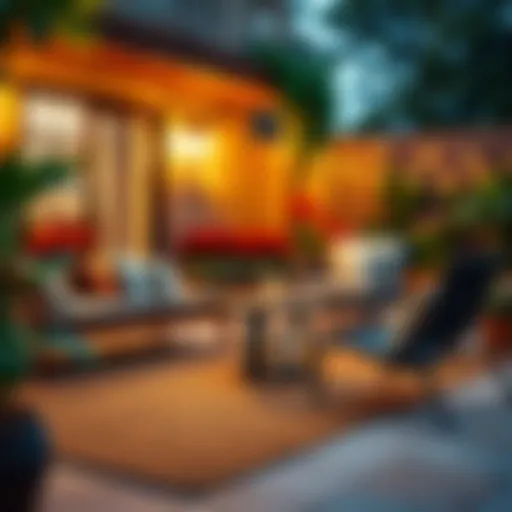Exploring High-Quality Garden Furniture Choices
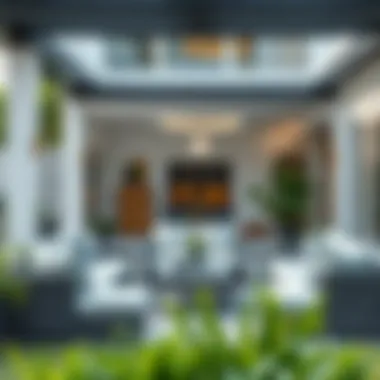

Intro
As homeowners and gardening enthusiasts alike strive to create outdoor spaces that resonate with their personal style, the selection of high-quality garden furniture emerges as a pivotal consideration. This goes beyond mere aesthetics; it’s about weaving together functionality and durability. In an age where outdoor living is not just a trend but a lifestyle, knowing how to navigate the myriad options available can transform a simple backyard into a stunning haven for relaxation and entertainment.
Outdoor furniture has come a long way, influenced by changing design trends and evolving consumer preferences. So, let us take a closer look at the latest furniture trends that are shaping modern outdoor spaces, as well as practical tips to ensure your investment stands the test of time. From the materials you choose to the maintenance practices you adopt, each detail plays a significant role in the overall experience of your outdoor sanctuary.
Understanding High-Quality Garden Furniture
When we think about outdoor living spaces, high-quality garden furniture often stands at the forefront of our considerations. This isn't just about aesthetics but about functionality, comfort, and long-term investment. High-quality garden furniture can transform the mere act of lounging outside into an experience of leisure and luxury. It’s paramount to understand what constitutes “quality” in this context, as it directly correlates with the durability and performance of these pieces over time.
Garden furniture serves as an extension of our living areas, giving us the freedom to enjoy the outdoors without compromising on comfort. Gone are the days of flimsy foldable chairs; today, homeowners are looking for pieces that not only meet their functional needs but also enhance their outdoor aesthetics. The relation between high-quality furniture and the overall ambiance of a garden or patio is substantial. When well-crafted, these pieces can act as focal points, drawing the eye and encouraging social interaction around them.
Defining Quality in Garden Furniture
Quality in garden furniture can be defined by several key characteristics. Materials, construction methods, and design all play a role in determining how well a piece will perform under the elements. When we talk about quality, it's not just about the price tag; a cheaper option might work beautifully if it is made from durable materials. A few indicators of quality include:
- Materials: The backbone of any piece of furniture. Teak, for example, provides natural oils that protect it from the elements, whereas plastic can degrade fast under UV exposure.
- Craftsmanship: A well-built chair or table will have seamless joints, stable legs, and smooth surfaces. Look for hand-finished details that testify to the care put into the product.
- Design: Quality should marry function with aesthetics. A beautiful piece that doesn’t serve its purpose—a sofa that’s lovely but uncomfortable—can’t be classified as truly high quality.
In essence, defining quality boils down to assessing these aspects critically. Ignoring them in favor of looks alone can lead to buyer’s remorse.
Importance of Durability
Durability is perhaps the crown jewel of high-quality garden furniture. It's what ties together investment with practicality. When you select furniture for outdoor use, the wear and tear from exposure to weather is a critical consideration. Durable furniture withstands not only the physical elements, such as rain and sun but also the test of time.
Consider this:
- Cost-effectiveness: While the upfront cost of high-quality pieces might be higher, the investment pays off over time. You won't be faced with constant replacements or repairs, which can stack up costs significantly.
- Safety and Comfort: Wobbly chairs or deteriorating tables can lead to accidents. Durable pieces ensure safety while also providing comfort, encouraging you and your guests to relax and enjoy.
- Aesthetic Longevity: Durable furniture maintains its visual appeal even after years of use. Faded colors and rusty metal can detract from your outdoor space's charm.
"Investing in durable garden furniture is akin to planting a tree; it provides shade today and roots deep for future generations to enjoy."
Materials Used in Garden Furniture
Choosing the right materials for garden furniture is crucial. Not only do they determine the aesthetic appeal, but they also affect the durability and overall functionality of the pieces. When considering garden furniture, one must keep in mind how materials interact with various weather conditions, maintenance requirements, and their environmental impact. The quality of materials used can make or break the longevity and enjoyment derived from outdoor living spaces.
Among the main materials, timber, metal, and synthetic options each come with their own sets of characteristics and benefits. Understanding these can help homeowners, designers, and DIY enthusiasts alike to make informed decisions. Let’s dive deeper into the different categories, starting with timber options that often bring a sense of authenticity and warmth to gardens.
Timber Options for Authenticity
Teak and its Resistance to the Elements
Teak wood is often hailed as one of the supreme choices for outdoor furniture. Its natural oils make it resistant to water and pests, thus positioning it favorably against harsh elements. This aspect of teak ensures that it maintains its structure and appearance for decades, making it a worthwhile investment for garden furniture.
One of the key characteristics of teak is its ability to withstand tannin leaching, which is vital in preventing stains or damage in rainy weather. This fact alone makes teak a sought-after material for homeowners looking to invest in durable outdoor pieces.
However, there’s a trade-off. Teak is typically more expensive than other woods due to its desirability and the controlled harvesting methods utilized. This cost can deter some, but the long-term benefits often justify the initial outlay.
Cedar: The Natural Insect Repellent
Cedar is another popular choice, particularly valued for its inherent insect repellent properties. The wood contains natural compounds that deter pests, a feature that is a boon for outdoor settings where insects can be a nuisance. This unique quality factors significantly into its popularity among many garden furniture designers.
Moreover, cedar is relatively lightweight, making it easier to move and rearrange as needed. It is also resistant to warping and shrinkage, leading to less maintenance over time. However, it does require regular sealing to maintain its color and avoid fading, especially in direct sunlight.
Hardwoods vs. Softwoods: A Comparative Study
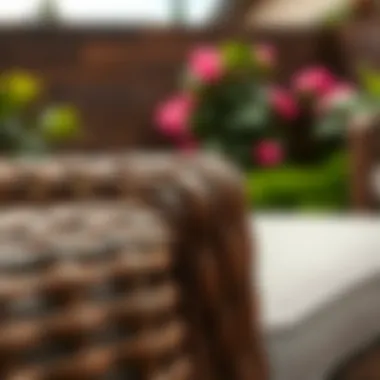
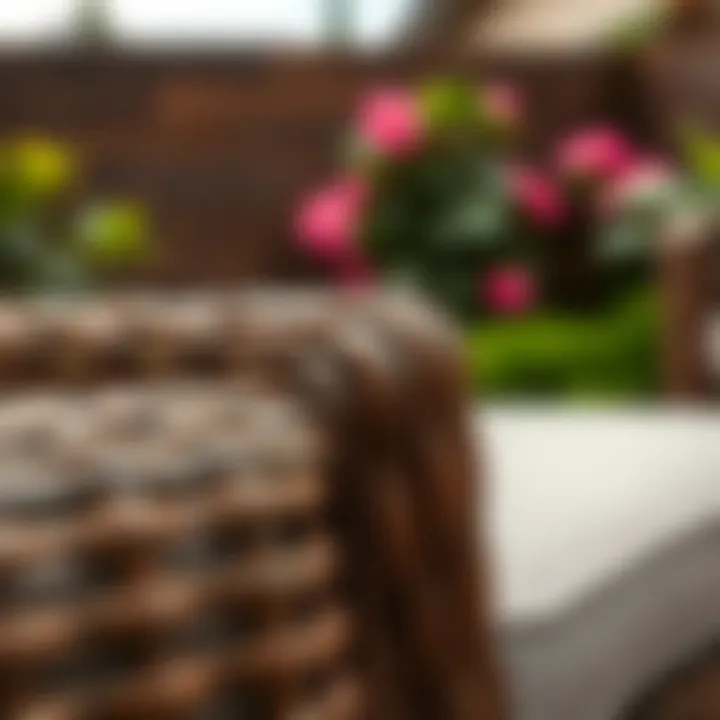
When it comes to selecting timber for garden furniture, understanding the differences between hardwoods and softwoods is crucial. Hardwoods, such as oak and mahogany, are known for their durability and resistance to damage. However, they tend to be heavier and require more care. On the flip side, softwoods, which include pine and cedar, are generally lighter and easier to work with but may not last as long or withstand harsh conditions as effectively.
Both options have their strengths; for instance, hardwoods can offer stunning visuals and longevity, while softwoods can provide cost-effective and functional solutions for lighter use. Ultimately, it boils down to the specific needs and environment where the furniture will reside.
Metal Choices for Strength
Aluminum: Lightweight Yet Sturdy
Aluminum has made significant inroads in the garden furniture market due to its remarkable combination of lightweight design and strength. One of its standout features is that it does not rust, which makes it ideal for outdoor use where moisture and humidity are commonplace. This resilience allows for easy mobility, which is particularly important for homeowners who like to rearrange their outdoor spaces.
Despite its lightweight nature, it offers exceptional durability. Many modern designs feature aluminum framed pieces that easily combine strength with style.
One point to be aware of is that while aluminum is resistant to corrosion, the quality can vary. Lower-grade aluminum may not perform as well over time, making it essential to select pieces that utilize high-quality materials.
Iron and Steel: The Classics of Robustness
Iron and steel remain some of the traditional staples in outdoor furniture, revered for their sturdiness and robustness. Heavier than aluminum, these materials can handle extreme weather conditions and offer a feeling of permanence in outdoor spaces.
A unique feature about cast iron is its intricately designed patterns, adding an aesthetic dimension that can appeal to classic decor preferences. However, they do require regular maintenance to prevent rusting, particularly if left outdoors without protective coatings.
While slightly cumbersome to move, pieces made from iron and steel can last a lifetime if cared for properly, which is a significant consideration for those looking to invest in garden furniture.
Corrosion Resistance in Marine Environments
For coastal areas, choosing materials like stainless steel becomes paramount, particularly due to their corrosion resistance in marine environments. Saltwater can wreak havoc on metals, but high-grade stainless steel is engineered precisely to withstand these harsh conditions.
A significant characteristic of this material is its create ability to maintain structural integrity and appearance over time, even in gritty sea air. Many homeowners in coastal regions find this an invaluable asset when selecting their outdoor furniture, ensuring that their investment sustains its quality for years.
Synthetic Materials and Their Benefits
Rattan Recreation: Weaving Aesthetics with Utility
Rattan furniture has gained traction not only due to its elegant appearance but also because of its practical uses. Modern synthetic rattan mimics the traditional look while adding benefits like weather resistance and durability. It doesn’t fade in the sun or deteriorate in rain, which makes it ideal for outdoor environments.
The aesthetic appeal of rattan furniture can elevate outdoor spaces instantly. Its woven texture complements various design styles, whether rustic or contemporary. However, it's prudent to check the quality of the synthetic material as there are vast differences in resilience based on manufacturing processes.
Polyethylene: Revolutionizing Outdoor Comfort
Polyethylene has emerged as a revolutionary player in outdoor furniture. Known for its flexibility and ability to withstand various temperatures, it can withstand heavy usage without compromising comfort. Being lightweight yet durable, furniture made from polyethylene can easily be rearranged without much hassle.
Moreover, technology has advanced enough to allow for the design of eye-catching pieces that mimic more traditional materials, giving consumers a broader range of options. However, cheaper versions may not have the same structural integrity, making knowledge about product quality vital.
When selecting materials for your garden furniture, it's essential to weigh the benefits and consider how each option aligns with your specific needs and preferences. This will not only enhance the functionality of your space but also elevate its aesthetic appeal.
Design Considerations in Garden Furniture
When venturing into the realm of garden furniture, design becomes a focal point. It's the bridge between functionality and personal expression, shaping how outdoor living spaces are experienced. Thoughtful design considerations can elevate a simple backyard into an inviting sanctuary or a lively gathering spot. So, let’s break down key elements contributing to successful garden furniture design.
Aesthetic Integration with Outdoor Spaces
Harmony with Landscaping
One of the key aspects is achieving harmony with landscaping. Garden furniture that sits well within the natural surroundings enhances the outdoor space significantly. For instance, a sleek, modern aluminum chair against a backdrop of lush greenery might create a stark contrast that feels out of place. Conversely, a wooden bench with a natural finish can mimic the textures and tones of surrounding trees, creating a seamless transition between furniture and nature.
Using colors and materials that reflect the existing landscape can make your outdoor area feel more cohesive and inviting. Natural wood finishes or muted earth tones often strike the right chords, making these pieces look less like intrusions and more like intended parts of the environment. However, it’s worth noting that designs lacking this harmony risk feeling disconnected, which can detract from a serene outdoor experience.
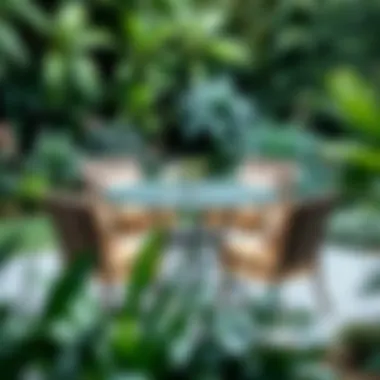

Color Schemes and Material Coordination
Next up is color schemes and material coordination. The colors and textures of your furniture should not only reflect personal style but also work in concert with the aesthetic of your garden. Perhaps you choose bright colors for vibrancy or soft hues for calmness—both approaches have their merit.
For instance, bright yellow cushions on a neutral-toned chair can give a pop of life while ensuring comfort. This strategic choice not only beautifies the space but also can evoke certain feelings. Yet, the balance is critical; if the colors clash, it may result in a chaotic visual experience.
Materials matter too. Coordinating plastics, metals, and textiles wisely can create visual intrigue. A mix of textures—like a wicker seating cluster paired with a metal fire pit—can offer dimensionality. One must tread carefully; misalignment here can lead to a bizarre visual experience.
Functional Aspects to Consider
Shifting gears, let’s dive deep into functionality—a sometimes-overlooked aspect that can profoundly affect the user experience. Not only should garden furniture look good, but it should also cater to day-to-day needs.
Comfort and Ergonomics
First, we have comfort and ergonomics. Furniture that is pleasing to the eye but uncomfortable can undermine the entire purpose of outdoor relaxation. Proper ergonomics in seating, for example, promotes good posture and increases the length of time one can comfortably enjoy a meal or a chat. Benches or chairs with thoughtful contouring can make all the difference, inviting guests to linger just a little longer.
Investing in quality cushions also enhances comfort, allowing for a more relaxed outdoor experience. Yet, be wary; some cushions, if not made for outdoor use, may fade or degrade under the sun's relentless rays. Thus, striking a balance between aesthetic appeal and long-lasting comfort is crucial.
Storage Solutions for Seasonal Changes
Finally, let’s address storage solutions for seasonal changes. Effective storage not only protects your investment but also keeps outdoor spaces organized. With seasonal shifts, having a place to store cushions, throws, or even the furniture itself becomes important.
A well-placed storage bench serves a dual purpose: seating during sunny days and storage when the rains come. Alternatively, custom-built outdoor boxes can keep items secure and dry while melding into the garden's design seamlessly. However, do make sure that these solutions are easily accessible; putting away furniture should not feel like a chore.
In summary, the nuances of design considerations, from aesthetic incorporation to functional attributes, play crucial roles in selecting high-quality garden furniture. Keeping these elements in mind can greatly enhance your outdoor living experience.
Trends in Garden Furniture
Trends in garden furniture can make or break the aesthetic and functional appeal of outdoor spaces. As homeowners increasingly seek to maximize their outdoor living areas, staying abreast of these trends isn’t just helpful; it’s essential. The garden furniture market, much like fashion, undergoes continual shifts that reflect broader lifestyle changes, environmental challenges, and design innovations. These trends hold numerous benefits, including the enhancement of property value and improved social spaces for gatherings. Therefore, it's crucial to consider what is resonating in contemporary outdoor design.
Minimalist Aesthetics in Outdoor Living
Minimalism emphasizes simplicity and functionality, making it a highly sought-after trend in garden furniture design. The philosophy behind minimalism is to create serene spaces that promote relaxation and mindfulness, free from clutter and distraction. Think about sleek lines, subtle colors, and practical pieces that have a dual purpose.
This trend taps into the idea that less is more. Furniture, like simple chairs or multifunctional tables, can elegantly stand out or blend in with nature. For instance, a slender, sun-bleached teak table surrounded by slim, metal chairs speaks volumes without overwhelming the visual landscape. Besides stylish appearances, clean designs often offer easier maintenance. When you have less to clean and maintain, you can enjoy your outdoor space instead of working on it.
Sustainable Practices: A Growing Concern
As awareness about environmental impact rises, sustainability has become a cornerstone in the evolution of garden furniture design. Eco-conscious consumers are not only looking for style and durability but also want products that minimize their carbon footprint.
Reclaimed Materials in Modern Design
Reclaimed materials have made waves in the garden furniture realm. This trend involves using wood or metal salvaged from old structures or products, transforming them into stylish outdoor furnishings. The beauty of reclaimed materials lies in their character—each piece has a unique history and charm, often telling a story of where it came from.
One key characteristic of reclaimed materials is their environmental impact. Using these resources reduces waste and decreases the demand for new raw materials. Moreover, reclaimed wood is often more durable, as it's typically older and more resistant to the elements than newly harvested wood. However, sourcing can be tricky; it requires careful selection to ensure quality.
In short, opting for reclaimed materials not only adds authenticity but also reflects a commitment to sustainability, making it a compelling choice for modern garden furniture.
Eco-Friendly Production Methods
Eco-friendly production methods are taking center stage, addressing concerns about manufacturing processes' environmental toll. This trend emphasizes using sustainable practices, low-impact materials, and energy-efficient technologies, all contributing to a greener planet. Companies dedicated to eco-friendliness often prioritize responsible sourcing and employ techniques that reduce water usage and waste.
A notable characteristic of these methods is transparency—more brands are open about their production processes and the origins of their materials. As consumers, this allows for informed decisions and encourages accountability among manufacturers. Adopting such practices might raise production costs initially, but the long-term gains in sustainability and customer loyalty are increasingly attractive.


Choosing the Right Garden Furniture
Picking garden furniture isn't just about aesthetics or functionality; it's about harmonizing both elements to create an outdoor experience that resonates with your personal style and meets practical needs. There's a multitude of choices out there, and without careful consideration, one might end up with pieces that clash with their outdoor space or simply don't stand the test of time. Understanding your requirements can aid in selecting the right garden furniture that doesn't just look good but also serves its purpose effectively.
Assessing Space and Utility
The first step in choosing the right garden furniture is understanding the space you have. Consider the layout of your garden or patio:
- Size Matters: Measure your area accurately. If your garden is small, go for foldable or stackable furniture, which can be easily tucked away. On the other hand, a larger space might accommodate a grand dining table or an intriguing sectional sofa.
- Flow and Function: Think about how the space will be used. If it’s primarily for relaxation, a couple of lounge chairs and a coffee table may suffice. If you intend to host gatherings, a large table and ample seating are necessary.
Additionally, keep in mind the garden's aesthetic. Choose pieces that complement your plants and landscaping. You don’t want a sleek modern look clashing with a rustic garden theme.
Budget Considerations for Quality Investments
Budgeting is crucial, and it can be tempting to skimp on furniture at the outset, but think long term. Investing a bit more upfront can save you headaches and costs down the line. Here's a breakdown of how to approach your budget:
- Quality Over Price: Sometimes, spending a few dollars more on high-quality materials can mean years of service. For instance, teak outdoor furniture is more expensive but offers durability and a stunning natural look over time.
- Consider Lifespan: Comoaring products, factor in their longevity and maintenance costs. Cheaper plastic likel y needs replacing after a few seasons, while well-made aluminum or teak furniture can last for decades with proper care.
- Evaluate Total Cost of Ownership: Think beyond the purchase cost. Include maintenance, storage solutions, and protective covers in your budget calculations.
"A well-invested garden furniture can transform your space and elevate your outdoor experiences significantly."
Ultimately, a well-planned budget will allow you not only to purchase the right pieces but also to enjoy them without the nagging worry of wear and tear or replacement costs looming overhead.
Care and Maintenance of Garden Furniture
Maintaining garden furniture is pivotal to extending its lifespan while keeping it looking sharp across seasons. Without diligent care, even the best-crafted pieces can fall victim to the elements, achieving little more than becoming unsightly eyesores in your outdoor space. Therefore, establishing a regular maintenance routine is not just beneficial; it's essential for the longevity and appearance of your investment.
Seasonal Maintenance Practices
Each season brings its own challenges for outdoor furniture. Here’s how to tackle the upkeep throughout the year:
- Spring Cleaning: Begin the warmer months by giving your furniture a thorough cleaning. Use a gentle soap solution and a soft brush to remove dust and debris that has collected during the winter. It’s the perfect time to inspect for any wear and tear as well.
- Summer Touch-Ups: During peak usage, keep an eye on any fading or peeling finishes, as the sun can be quite harsh. You might consider applying a fresh coat of sealant or stain to enhance protection.
- Autumn Preparation: Before the leaves fall, cleaning your furniture and protecting it from potential staining is critical. Spot clean any spills, and remember to cover any pieces not intended for the cold months ahead.
- Winter Care: If you can’t store your pieces indoors, cover them with weatherproof materials. It helps to prevent moisture accumulation and extends their life considerably.
Protective Measures Against Elements
Understanding how to shield outdoor furniture from damage can save you time and money. Two primary strategies are using covers and implementing proper storage techniques.
Use of Covers
Covers are often regarded as the first line of defense against the elements. Investing in high-quality, fitted covers can make a world of difference.
- Key Characteristics: A good cover is typically made of durable, weather-resistant fabric that provides a shield against UV rays, rain, and snow.
- Benefits: By keeping the furniture dry, covers minimize rust and rot, which are the arch-nemeses of outdoor furniture. Plus, they reduce the frequency of cleaning sessions considerably, making them a practical choice for busy homeowners.
- Unique Features: Many covers come with features like ventilation ports to prevent moisture from accumulating beneath them, thereby allowing airflow while still protecting your furniture.
"Using protective covers can double the life expectancy of your outdoor furniture, keeping it in pristine condition through changing weather conditions."
Proper Storage Techniques
Storing garden furniture correctly when not in use can significantly contribute to its longevity.
- Key Characteristics: The best storage solutions often include sheltered sheds, dry basements, or even garages. If you choose to stack your furniture, do it carefully to avoid scratches or dents.
- Benefits: Proper storage prevents exposure to elements like rain, snow, and extreme temperatures. This method not only keeps your furniture looking new but also saves on repairs or replacements.
- Unique Features: Certain furniture pieces are designed to be modular or foldable, which can enhance storage convenience. This trait allows for easy maneuvering and maximizes storage space.
Ending
In the realm of outdoor living, the selection of high-quality garden furniture stands as a pivotal element that goes beyond mere aesthetics. It embodies a thoughtful interplay of style, durability, and functionality, representing an investment in not just the immediate environment but also in long-term satisfaction and utility. As homeowners, designers, and DIYers navigate the myriad choices available, the significance of investing in well-crafted pieces becomes evident.
Investing in Quality for Long-Term Gain
Investing in quality garden furniture ensures that these pieces will withstand the test of time and the elements. Key considerations when evaluating quality involve the materials used, the craftsmanship evident in the design, and how well the furniture aligns with your specific needs and space.
- Longevity: High-quality garden furniture, crafted from durable materials like teak, aluminum, or high-density polyethylene, offers remarkable longevity. These materials don’t just promise beauty; they resist fading, warping, and wear, thus saving homeowners from frequent replacements.
- Value for Money: While upfront costs may be higher when choosing premium options, the value derived is substantial over time. Cheaper alternatives may appear attractive initially but often lead to increased spending due to frequent replacements. Choosing quality pieces can lead to significant savings in the long run.
- Design Versatility: Quality furniture often features designs that are not only timeless but also adaptable to changing trends or purposes. This flexibility means you can invest once and enjoy a lasting aesthetic—whether you’re hosting a summer barbecue or simply enjoying quiet evenings.
"Choosing quality garden furniture is like building a strong foundation for your outdoor space; you set the stage for comfort, joy, and memorable moments for years to come."















